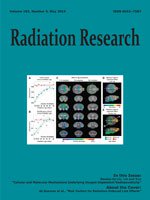For the last two decades radiation-induced bystander effects (RIBEs) have attracted significant attention due to their possible implications for radiotherapy. However, despite extensive research, the molecular pathways associated with RIBEs are still not completely known. In the current study we investigated the role of senescence in the bystander response. Irradiated (2, 4, 6 and 8 Gy) human colorectal carcinoma cells (HCT116) with p53 / (wild-type) or p53–/– (knockout) gene were co-incubated with nonirradiated cells of the same type. Clonogenic and senescence assays were used for both irradiated and co-incubated bystander cell populations. We also performed additional measurements on the number of remaining cells after the whole co-incubation period. For radiation doses larger than 2 Gy we observed much larger fractions of senescent cells in p53-positive populations compared to their p53-negative counterparts (15.81% vs. 3.63% in the irradiated population; 2.89% vs. 1.05% in the bystander population; 8 Gy; P < 0.05). Statistically significant differences between cell lines in the clonogenic cell surviving fraction were observed for doses higher than 4 Gy (1.61% for p53 / vs. 0.19% for p53–/– in irradiated population; 3.57% for / vs. 50.39% for –/– in bystander population; 8 Gy; P < 0.05). Our main finding was that the number of senescent cells in the irradiated population correlated strongly with the clonogenic cell surviving fraction (R = −0.98, P < 0.001) and the number of senescent cells (R = 0.97, P < 0.001) in the bystander population. We also extended the standard linear-quadratic radiation response model by incorporating the influence of the signals released by the senescent cells, which accurately described the radiation response in the bystander population. Our findings suggest that radiation-induced senescence might be a key player in RIBE, i.e., the strength of RIBE depends on the amount of radiation-induced senescence.
How to translate text using browser tools
6 April 2015
Connecting Radiation-Induced Bystander Effects and Senescence to Improve Radiation Response Prediction
Jan Poleszczuk,
Aleksandra Krzywon,
Urszula Forys,
Maria Widel
ACCESS THE FULL ARTICLE

Radiation Research
Vol. 183 • No. 5
May 2015
Vol. 183 • No. 5
May 2015




